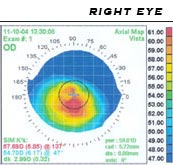
Photo from wikipedia
Purpose To analyze the keratectasia area (KEA) shown in corneal topography before and after corneal cross-linking (CXL) in patients with progressive keratoconus (KC) and figure out whether KEA is appropriate… Click to show full abstract
Purpose To analyze the keratectasia area (KEA) shown in corneal topography before and after corneal cross-linking (CXL) in patients with progressive keratoconus (KC) and figure out whether KEA is appropriate for evaluating the effect of CXL. Methods A retrospective analysis was conducted in 34 eyes from 24 progressive KC patients who have underwent CXL from 2015 to 2017. Area with K-value more than 47D shown in the corneal topography was marked and identified as KEA. Keratometry (K1, K2, and Kmax), KEA, thinnest corneal thickness (TCT), and endothelial cell density (ECD) were evaluated preoperatively or at months 3, 6, and 12 postoperatively. The changes of KEA before and after operation were evaluated. The relation of KEA and other parameters, including Kmax and TCT, was analyzed. Results Linear regression model revealed the KEA, Kmax, K1, and K2 decreased after CXL in model y = 0.9622 -0.02408 x (P<0.05), y = 0.9982 -0.003469 x(P<0.05), y = 0.9977 + -0.001347 x(P<0.05), y = 0.9992 + -0.001779 x(P<0.05) (y represents KEA, Kmax, K1, or K2; x represents time (month)). The KEA is significantly decreased in early stage (before month 3) (P<0.05); however, the Kmax, K1, and K2 have no significant decrease in early stage (P= 0.09, 0.19, 0.32). Conclusions The KEA is more sensitive than K-value in describing the morphological changes of cornea after CXL, especially in early stage after treatment.
Journal Title: BioMed Research International
Year Published: 2019
Link to full text (if available)
Share on Social Media: Sign Up to like & get
recommendations!